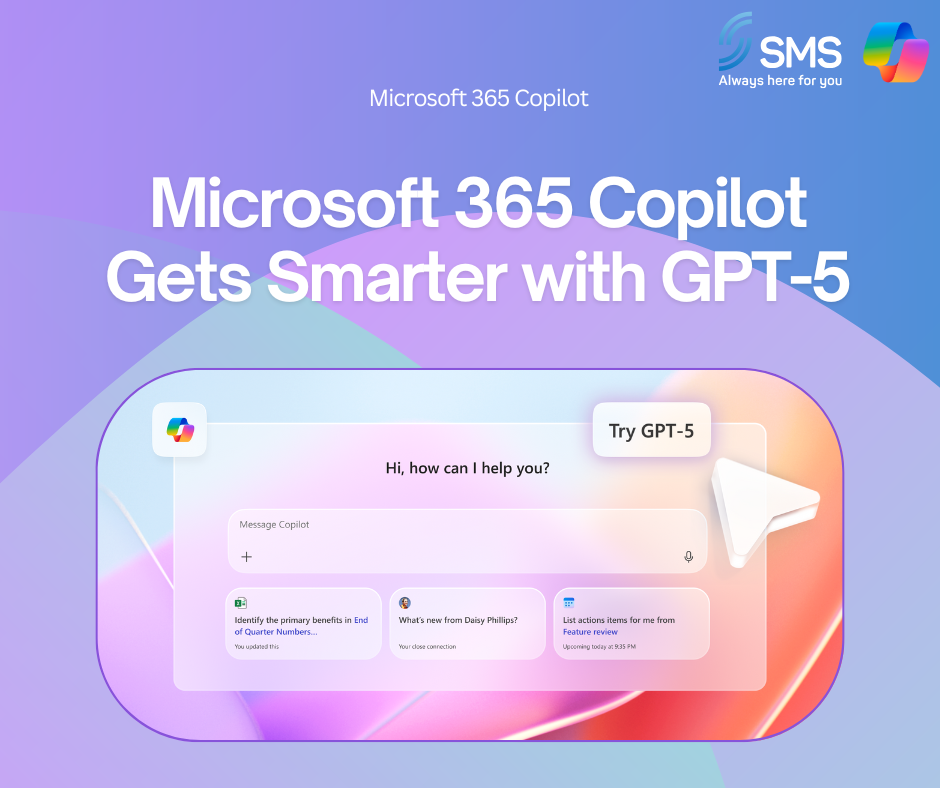Microsoft has introduced GPT-5, OpenAI’s latest AI model, into Microsoft 365 Copilot Chat — making Copilot even more powerful across the apps you use every day. From quick answers to complex analysis, Copilot now taps into GPT-5 to deliver deeper reasoning, smarter summaries, and stronger support for your business.
What GPT-5 Brings to Copilot
-
Smarter task handling – Whether you need a simple answer or an in-depth executive report, Copilot automatically chooses the right AI model for the job.
-
Data-driven insights – Upload spreadsheets, reports, or customer feedback and let Copilot create clear, professional outputs for decision-making.
-
Enterprise security built-in – As part of Microsoft 365, GPT-5 inside Copilot comes with the compliance, security, and privacy standards you already trust.
-
Available anywhere – GPT-5 in Copilot Chat is live now on Desktop, Web, and iOS, with Android coming soon.
This upgrade means your team can work smarter and faster, without worrying about where their data goes or whether the AI will keep up with them.
Copilot GPT-5 vs. ChatGPT GPT-5: What’s the Difference?
Even though both use the same underlying GPT-5 model, the experience is very different:
-
Integration vs. standalone – In ChatGPT, GPT-5 runs as a single, raw model. In Copilot, Microsoft has built a “router” that decides when to use GPT-5 or other AI models depending on the task, meaning you get the most effective response for the situation.
-
Business context – Copilot is tied directly into Microsoft 365 apps like Word, Excel, Outlook, and Teams. It doesn’t just answer questions — it works with your files, data, and workflows. ChatGPT can’t access those integrations out of the box.
-
Security & compliance – Copilot runs inside Microsoft’s trusted enterprise framework, ensuring data stays secure and compliant with business standards. ChatGPT, while powerful, doesn’t automatically offer that same enterprise-level assurance.
-
User experience – Many ChatGPT users have criticised GPT-5’s rollout as clunky and less natural than GPT-4. In contrast, Copilot smooths that out by combining GPT-5 with Microsoft’s tooling, delivering more consistent and polished results.
A Note on ChatGPT’s Rocky GPT-5 Launch
While GPT-5 is proving valuable inside Microsoft Copilot, its standalone debut in ChatGPT was less smooth. As we covered in our recent blog GPT-5 Rollout: A Bumpy Launch and Microsoft’s Copilot’s Continued Dominance, many users felt the early rollout was disappointing, describing responses as flat, error-prone, and lacking the natural nuance of GPT-4.
OpenAI’s CEO, Sam Altman, even admitted the launch was ‘totally screwed up’, promising improvements to restore user confidence. It’s a reminder that while the technology is powerful, execution matters just as much as capability.
Why Microsoft Copilot Gets It Right
The difference lies in how Microsoft has integrated GPT-5 into Copilot:
-
Instead of dropping a brand-new model straight into users’ hands, Microsoft routes prompts through the best available model for the task.
-
Features like Excel’s upcoming =COPILOT function show how AI is being woven directly into the workflows people rely on.
-
Enterprise customers get reliability, security, and control — making Copilot not just cutting-edge, but business-ready.
Final Thoughts
GPT-5 marks another step forward in AI — and while its rollout in ChatGPT has been shaky, inside Microsoft 365 Copilot it’s a game-changer. By combining powerful AI with Microsoft’s trusted productivity tools, Copilot gives businesses the best of both worlds: smarter work and peace of mind.
👉 If you’d like to explore how Copilot can benefit your organisation, visit all our information on Copilot today.


